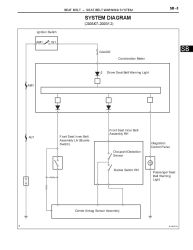Scion xB 2003-2015 Workshop Repair & Service Manual
Catalog:
Model:
Complete digital official workshop manual contains service, maintenance, and troubleshooting information for the Scion xB 2003-2015. Diagnostic and repair procedures are covered in great detail to repair, maintain, rebuild, refurbish or restore your vehicle like a professional mechanic in local service/repair workshop. This cost-effective quality manual is 100% complete and intact as should be without any missing pages. It is the same factory shop manual used by dealers that guaranteed to be fully functional to save your precious time.
This manual for Scion xB 2003-2015 is divided into different sections. Each section covers a specific component or system and, in addition to the standard service procedures, includes disassembling, inspecting, and assembling instructions. A table of contents is placed at the beginning of each section. Pages are easily found by category, and each page is expandable for great detail. It is in the cross-platform PDF document format so that it works like a charm on all kinds of devices. You do not need to be skilled with a computer to use the manual.
MAKE: Scion
MODEL: xB (a.k.a. Toyota bB/Daihatsu Materia/Coo)
YEAR: 2003 2004 2005 2006 2007 2008 2009 2010 2011 2012 2013 2014 2015
EXCERPT:
POWER STEERING – POWER STEERING SYSTEM
ON-VEHICLE INSPECTION (2005/12- )
1. INSPECT DRIVE BELT
(a) Visually check the belt for excessive wear, frayed cords, etc. If any defect is found, replace the drive belt.
HINT: Cracks on the rib side of the belt are considered acceptable. Replace the belt if there are any missing ribs.
2. BLEED AIR FROM POWER STEERING SYSTEM
(a) Check the fluid level.
(b) Jack up the front of the vehicle and support it with stands.
(c) Turn the steering wheel.
(1) With the engine stopped, turn the steering wheel slowly from lock to lock several times.
(d) Lower the vehicle.
(e) Start the engine. Run the engine at idle for a few minutes.
(f) Turn the steering wheel.
(1) With the engine idling, turn the steering wheel to the left or right full lock position and hold it there for 2 to 3 seconds. Then turn the steering wheel to the opposite full lock position and hold it there for 2 to 3 seconds.
(2) Repeat the step above several times.
(g) Stop the engine.
(h) Check for foaming or emulsification. If the system has to be bled twice because of foamimg or emulsification, check for fluid leaks in the system.
(i) Check the fluid level.
3. CHECK FLUID LEVEL
(a) Keep the vehicle level.
(b) With the engine stopped, check the power steering fluid level in the oil reservoir. If necessary, add power steering fluid.
Power steering fluid: ATF "DEXRON" II or III
HINT: If the fluid is hot, check that the fluid level is within the HOT range on the oil reservoir. If the fluid is cold, check that the fluid level is within the COLD
range.
(c) Start the engine and run it at idle.
(d) Turn the steering wheel to the left or right full lock position. Then turn the steering wheel to the opposite full lock position. Repeat this several times to raise the fluid temperature.
Standard fluid temperature: 80°C (176°F)
(e) Check for foaming or emulsification. If foaming or emulsification is identified, bleed air from the power steering system.
(f) With the engine idling, measure the fluid level in the oil reservoir.
(g) Stop the engine.
(h) Wait a few minutes and remeasure the fluid level in the oil reservoir.
Maximum fluid level increase: 5 mm (0.20 in.)
If a problem is found, bleed air from the power steering system.
(i) Check the fluid level.
4. CHECK STEERING FLUID PRESSURE
(a) Disconnect the pressure feed tube (see page PS-12).
(b) Connect SST as shown in the illustration below. SST 09640-10010 (09641-01010, 09641-01030, 09641-01060)
NOTICE: Check that the valve of SST is in the open position.
(c) Bleed air from the power steering system.
(d) Start the engine and run it at idle.
(e) Turn the steering wheel to the left or right full lock position. Then turn the steering wheel to the opposite full lock position. Repeat this several times to raise fluid temperature.
Standard fluid temperature: 75 to 80°C (167 to 176°F)
...





